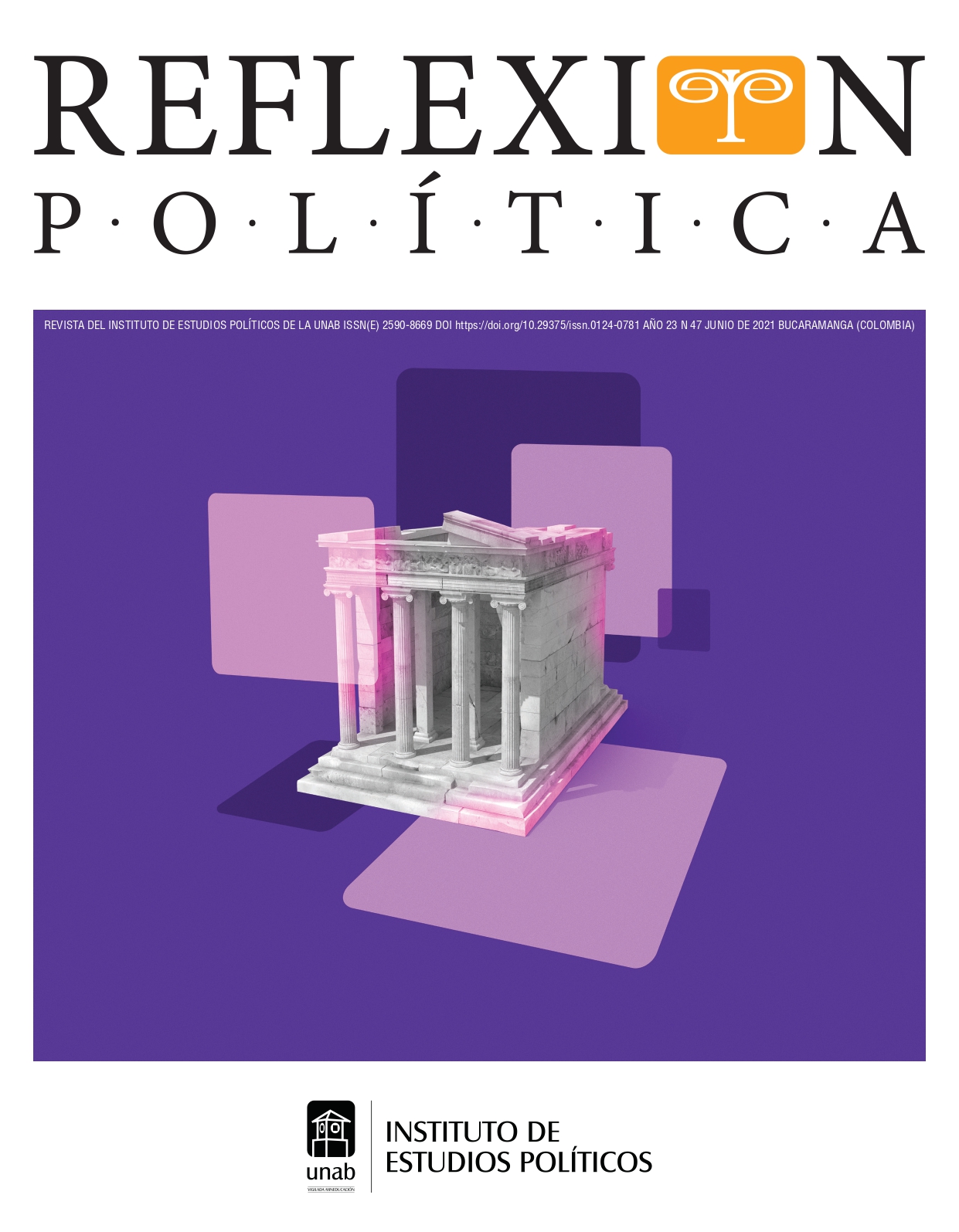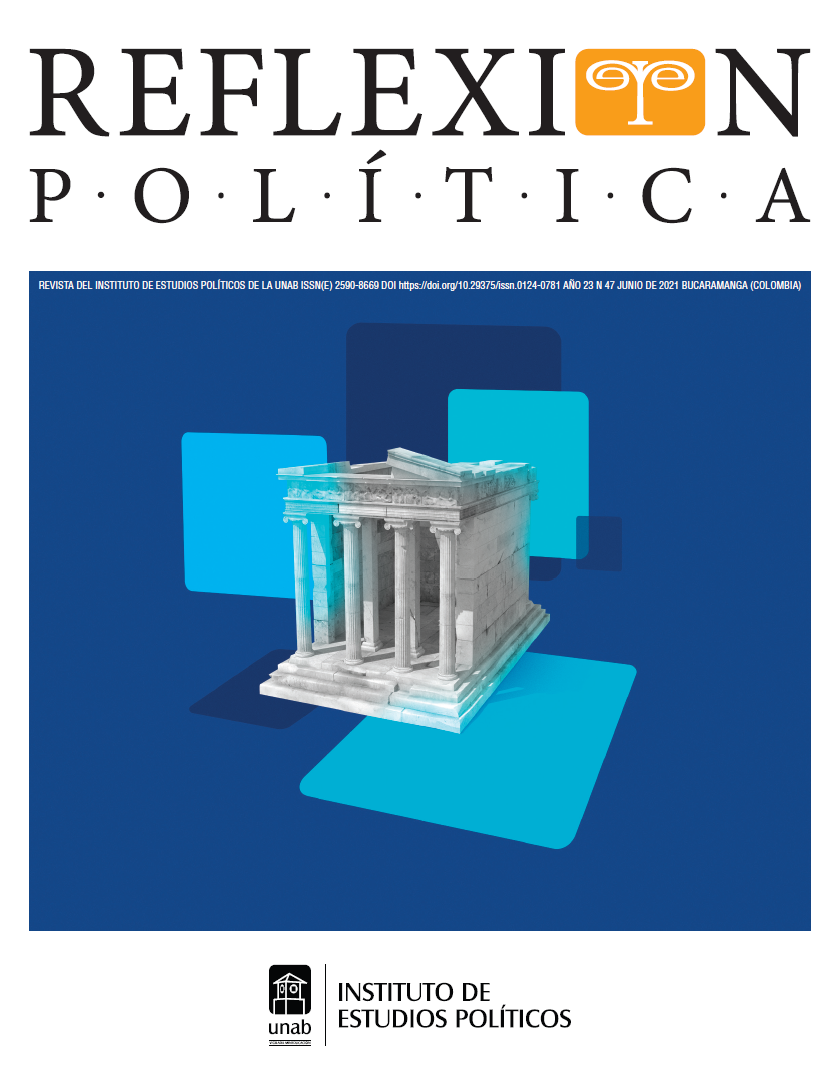El marco analítico de la construcción social
Un enfoque crítico para analizar el diseño de las políticas públicas.
Resumen
En este artículo se presenta el marco analítico de Ingram y Schneider para estudiar el rol explicativo de las construcciones sociales de los grupos meta en el diseño de políticas públicas. Para tal finalidad se realizó una indagación bibliográfica de la aplicación del marco en investigaciones empíricas. Así mismo, se revisaron diversas fuentes primarias de las autoras del marco para sintetizar una versión consolidada, tanto de su estructura como de su operabilidad empírica en el análisis de políticas públicas. Del mismo modo, se dejó abierta la discusión sobre la pertinencia de conectar la categoría de interseccionalidad con la aplicación del marco analítico en investigaciones empíricas. Se concluye que el marco ha logrado notoriedad y enraizamiento, especialmente en el sector de políticas sociales en el contexto académico anglófono, por su capacidad de integrar al análisis de las políticas el papel explicativo de las percepciones, representaciones e interpretaciones de los actores en las fórmulas de distribución de beneficios y restricciones públicas.
Referencias bibliográficas
Bourdieu, P. (1985). The social space and the genesis of groups. Social Science Information, 24(2), 195-220. https://doi.org/10.1177/053901885024002001
Campbell, A. L. (2011). How policies make citizens: Senior political activism and the American welfare state. In How Policies Make Citizens: Senior Political Activism and the American Welfare State (Vol. 83). Princeton University Press. https://doi.org/10.1215/03616878-2006-007
Campbell, A. L. (2012). Policy makes mass politics. Annual Review of Political Science, 15, 333-351. https://doi.org/10.1146/annurev-polisci-012610-135202
Campbell, A. L. (2020). The Affordable Care Act and mass policy feedbacks. Journal of Health Politics, Policy and Law, 45(4), 567-580. https://doi.org/10.1215/03616878-8255493
Collins, P. H. (2015). Intersectionality's definitional dilemmas. Annual review of sociology, 41, 1-20. https://doi.org/10.1146/annurev-soc-073014-112142
Crenshaw, K. (1990). Mapping the margins: Intersectionality, identity politics, and violence against women of color. Stan. L. Rev., 43, 1241. https://doi.org/10.2307/1229039
DeLeon, P., & Martell, C. R. (2006). The policy sciences: past, present, and future. Handbook of public policy, 31-47. https://doi.org/10.4135/9781848608054.n3
Donovan, M. C. (1993). Social constructions of people with AIDS: Target populations and United States policy, 1981–1990. Review of Policy Research, 12(3‐4), 3-29. https://doi.org/10.4135/9781848608054.n3
Donovan, M. C. (2014). The problem with making AIDS comfortable: Federal policymaking and the rhetoric of innocence. In M C Donovan (Ed.), Activism and Marginalization in the AIDS Crisis, 139–168. https://doi.org/10.4324/9781315865515-11
Hall, P. A. (1993). Policy paradigms, social learning, and the state: the case of economic policymaking in Britain. Comparative politics, 275-296. https://doi.org/10.2307/422246
Hogan, N. L. (1997). The social construction of target populations and the transformation of prison-based AIDS policy: A descriptive case study. Journal of Homosexuality, 32(3–4), 77–114. https://doi.org/10.1300/J082v32n03_04
Husmann, M. A. (2015). Social constructions of obesity target population: an empirical look at obesity policy narratives. Policy Sciences, 48(4), 415–442. https://doi.org/10.1007/s11077-015-9229-6
Hynes, B. O. D., & Hayes, N. (2011). Who benefits from early childcare subsidy design in Ireland? Journal of Poverty and Social Justice, 19(3), 277–288. https://doi.org/10.1332/175982711X597017
Ingram, H., & Schneider, A. L. (1997). Policy design for democracy. Lawrence: University Press of Kansas.
Ingram, H., & Schneider, A. L. (Eds.). (2005). Deserving and entitled: Social constructions and public policy. SUNY Press.
Ingram, H., & Schneider, A. L. (2015). 14 Making distinctions: the social construction of target populations.
Handbook of Critical Policy Studies, 259. https://doi.org/10.4337/9781783472352.00022
Ingram, H., Schneider, A. L., & DeLeon, P. (2007). Social Construction and Policy Design. En. PA Sabatier (Ed.), Theories of the Policy Process (93-126).. Boulder.
Lasswell, H. D. (1970). The emerging conception of the policy sciences. Policy Sciences, 1(1), 3–14.
Lasswell, H. D. (1971). A pre-view of policy sciences. American Elsevier Publishing Company New York.
Lowi, T. J. (1972). Four systems of policy, politics, and choice. Public administration review, 32(4), 298-310. https://doi.org/10.2307/974990
McCall, L. (2005). The complexity of intersectionality. Signs: Journal of women in culture and society, 30(3), 1771-1800. https://doi.org/10.1086/426800
Mannheim, K. (2013). Ideology and utopia. London: Routledge. https://doi.org/10.4324/9781315002828
Mettler, S., & Soss, J. (2004). The consequences of public policy for democratic citizenship: Bridging policy studies and mass politics. Perspectives on Politics, 2(1), 55–73. https://doi.org/10.1017/S1537592704000623
Nicholson-Crotty, J., & Nicholson-Crotty, S. (2004). Social construction and policy implementation: Inmate health as a public health issue. Social Science Quarterly, 85(2), 240–256. https://doi.org/10.1111/j.0038-4941.2004.08502002.x
Patterson, D. A., & Keefe, R. H. (2008). Using social construction theory as a foundation for macro-level interventions in communities impacted by HIV and addictions. Journal of Sociology and Social Welfare, 35(2), 111–126.
Pierce, J. J., Siddiki, S., Jones, M. D., Schumacher, K., Pattison, A., & Peterson, H. (2014). Social construction and policy design: A review of past applications. Policy Studies Journal, 42(1), 1-29. https://doi.org/10.1111/psj.12040
Pierson, P. (1993). When effect becomes cause: Policy feedback and political change. World Politics, 45(4), 595–628. https://doi.org/10.2307/2950710
Rochefort, D. A., & Cobb, R. W. (Eds.). (1994). The politics of problem definition: Shaping the policy agenda. Kansas: University Press of Kansas.
Schneider, A., & Sidney, M. (2009). What is next for policy design and social construction theory? 1. Policy Studies Journal, 37(1), 103-119. https://doi.org/10.1111/j.1541-0072.2008.00298.x
Schroedel, J. R., & Jordan, D. R. (1998). Senate voting and social construction of target populations: A study of AIDS policy making, 1987-1992. Journal of Health Politics, Policy and Law, 23(1), 107–132. https://doi.org/10.1215/03616878-23-1-107
Simon, H. A. (1997). Models of bounded rationality: Empirically grounded economic reason (Vol. 3). MIT press.
Soss, J. (2005). Making clients and citizens: Welfare policy as a source of status, belief, and action. Deserving and Entitled: Social Constructions and Public Policy, 291–328.
Soss, J., & Schram, S. F. (2007). A public transformed? Welfare reform as policy feedback. American Political
Science Review, 101(1), 111-127. https://doi.org/10.1017/S0003055407070049
Weible, C. M., & Sabatier, P. A. (Eds.). (2018). Theories of the policy process. New York: Routledge. https://doi.org/10.4324/9780429494284
Descargas
Derechos de autor 2022 Reflexión Política

Esta obra está bajo una licencia internacional Creative Commons Atribución-NoComercial-SinDerivadas 4.0.
| Estadísticas de artículo | |
|---|---|
| Vistas de resúmenes | |
| Vistas de PDF | |
| Descargas de PDF | |
| Vistas de HTML | |
| Otras vistas | |



















